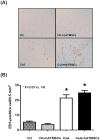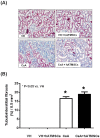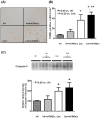Human adipose tissue derived mesenchymal stem cells aggravate chronic cyclosporin nephrotoxicity by the induction of oxidative stress
- PMID: 23555748
- PMCID: PMC3608559
- DOI: 10.1371/journal.pone.0059693
Human adipose tissue derived mesenchymal stem cells aggravate chronic cyclosporin nephrotoxicity by the induction of oxidative stress
Abstract
The aim of this study was to investigate whether hATMSCs protect against cyclosporine (CsA)-induced renal injury. CsA (7.5 mg/kg) and hATMSCs (3×10(6)/5 mL) were administered alone and together to rats for 4 weeks. The effect of hATMSCs on CsA-induced renal injury was evaluated by assessing renal function, interstitial fibrosis, infiltration of inflammatory cells, and apoptotic cell death. Four weeks of CsA-treatment produced typical chronic CsA-nephropathy. Combined treatment with CsA and hATMSCs did not prevent these effects and showed a trend toward further renal deterioration. To evaluate why hATMSCs aggravated CsA-induced renal injury, we measured oxidative stress, a major mechanism of CsA-induced renal injury. Both urine and serum 8-hydroxydeoxyguanosine(8-OHdG) levels were higher in the CsA+hATMSCs group than in the CsA group (P<0.05). An in vitro study showed similar results. Although the rate of apoptosis did not differ significantly between HK-2 cells cultured in hATMSCs-conditioned medium and those cultured in DMEM, addition of CsA resulted in greater apoptosis in HK-2 cells cultured in hATMSCs-conditioned medium. Addition of CsA increased oxidative stress in the hATMSCs-conditioned medium. The results of our study suggest that treatment with hATMSCs may aggravate CsA-induced renal injury because hATMSCs cause oxidative stress in the presence of CsA.
Conflict of interest statement
Figures








Similar articles
-
Protective effect of paricalcitol on cyclosporine-induced renal injury in rats.Transplant Proc. 2012 Apr;44(3):642-5. doi: 10.1016/j.transproceed.2011.12.004. Transplant Proc. 2012. PMID: 22483459
-
Ginseng treatment attenuates chronic cyclosporine nephropathy via reducing oxidative stress in an experimental mouse model.Am J Nephrol. 2013;37(5):421-33. doi: 10.1159/000349921. Epub 2013 Apr 10. Am J Nephrol. 2013. PMID: 23594788
-
Bone mesenchymal stem cells pretreated with erythropoietin enhance the effect to ameliorate cyclosporine A-induced nephrotoxicity in rats.J Cell Biochem. 2018 Nov;119(10):8220-8232. doi: 10.1002/jcb.26833. Epub 2018 Jun 22. J Cell Biochem. 2018. PMID: 29932236
-
Cyclosporine-assisted adipose-derived mesenchymal stem cell therapy to mitigate acute kidney ischemia-reperfusion injury.Stem Cell Res Ther. 2013 May 31;4(3):62. doi: 10.1186/scrt212. Stem Cell Res Ther. 2013. PMID: 23726287 Free PMC article.
-
Huangqi and Danshen improve the chronic nephrotoxicity of cyclosporin A by regulating lipid metabolism.Phytomedicine. 2025 May;140:156582. doi: 10.1016/j.phymed.2025.156582. Epub 2025 Feb 25. Phytomedicine. 2025. PMID: 40056636
Cited by
-
Mesenchymal Stem Cells in Renal Fibrosis: The Flame of Cytotherapy.Stem Cells Int. 2019 Jan 13;2019:8387350. doi: 10.1155/2019/8387350. eCollection 2019. Stem Cells Int. 2019. PMID: 30766607 Free PMC article. Review.
-
Are They Really Stem Cells? Scrutinizing the Identity of Cells and the Quality of Reporting in the Use of Adipose Tissue-Derived Stem Cells.Stem Cells Int. 2016;2016:2302430. doi: 10.1155/2016/2302430. Epub 2015 Dec 20. Stem Cells Int. 2016. PMID: 26798353 Free PMC article.
-
Effect of human umbilical cord blood-mesenchymal stem cells on cisplatin-induced nephrotoxicity in rats.Mol Biol Rep. 2024 Jan 28;51(1):234. doi: 10.1007/s11033-023-08958-5. Mol Biol Rep. 2024. PMID: 38282086
-
Cell-based therapies for experimental chronic kidney disease: a systematic review and meta-analysis.Dis Model Mech. 2015 Mar;8(3):281-93. doi: 10.1242/dmm.017699. Epub 2015 Jan 29. Dis Model Mech. 2015. PMID: 25633980 Free PMC article.
-
Conversion to sirolimus ameliorates cyclosporine-induced nephropathy in the rat: focus on serum, urine, gene, and protein renal expression biomarkers.Biomed Res Int. 2014;2014:576929. doi: 10.1155/2014/576929. Epub 2014 May 19. Biomed Res Int. 2014. PMID: 24971338 Free PMC article.
References
-
- Bennett WM, DeMattos A, Meyer MM, Andoh T, Barry JM (1996) Chronic cyclosporine nephropathy: the Achilles’ heel of immunosuppressive therapy. Kidney Int 50: 1089–1100. - PubMed
-
- Myers BD, Ross J, Newton L, Luetscher J, Perlroth M (1984) Cyclosporine-associated chronic nephropathy. N Engl J Med 311: 699–705. - PubMed
-
- Wang C, Salahudeen AK (1995) Lipid peroxidation accompanies cyclosporine nephrotoxicity: effects of vitamin E. Kidney Int. 47: 927–934. - PubMed
-
- Yang CW, Faulkner GR, Wahba IM, Christianson TA, Bagby GC, et al. (2002) Expression of apoptosis-related genes in chronic cyclosporine nephrotoxicity in mice. Am J Transplant 2: 391–399. - PubMed
Publication types
MeSH terms
Substances
LinkOut - more resources
Full Text Sources
Other Literature Sources

